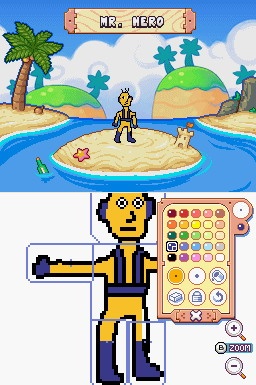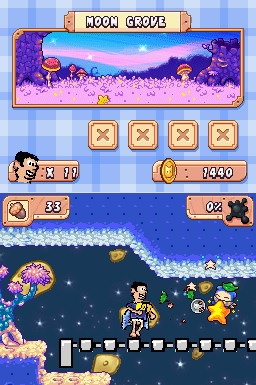Drawn to Life for the Nintendo DS is probably the best $30 coloring book you'll ever play. In a nutshell, the game is a platformer that allows you a bit of freedom of artistic expression. It lets you use the stylus to draw and design a variety of things, from the weapons you use, right down to your very own avatar. It sounds like the picture-perfect concept for a DS game, and in most ways, it delivers on its promise. You can indeed draw and design lots of unique images, even if some of those images are limited by static outlines provided to you. If the game has any flaw, it's that it's not necessarily that interesting as a game. It's the kind of plain-and-simple platformer that's been done to death, with a few fetch quests tossed in to pad out the experience. However, for less experienced players, the overly familiar gameplay won't be as big of a deal. Even with some limitations, the artistic aspects of the game are undeniably cool.

The premise of Drawn to Life involves a breed of adorable cat/rodent-looking creatures called raposas, a cheerful race that has fallen on hard times due to a viral darkness plaguing the land. Dark clouds are choking the life out of the raposas' modest village, specifically due to the destroyed pages of "the book of life," which is a book that literally contains all the items needed for living (the sun, night, time, rain, and so on and so forth). Also absent is "The Creator," the god that the raposas worship, who evidently abandoned them sometime ago. Wouldn't you know it, but that god is you, and after you decide to start speaking to the young daughter of the town's mayor, the once-downtrodden raposas are suddenly bristling with excitement and asking you for favor after favor to help rid their town of this pesky darkness.
Of course, no god worth its salt actually does all this work itself. Rather than just wiping out all the darkness with one fell stroke, you instead dig up a mannequin that's been locked away inside the town's library. This is where you get your first taste of the game's sketching abilities. You're given the task of crafting this mannequin into a character of your own design. Using either a selection from the default character templates, or the available color palette for drawing and coloring, you create whatever kind of goofy hero you want. Whether you want a fairly by-the-book superhero or something that looks like a cross between Mega Man and Gene Simmons, you can make a pretty good approximation of whatever you want. The limitations of the game's drawing mechanics do become somewhat apparent here. Though you can zoom in a fair amount for more precise drawing, all the art is done with fairly sizeable pixels, so it's difficult to avoid slightly jagged-looking designs. In addition, the touch screen doesn't always recognize the stylus with perfect accuracy. Sometimes you'll attempt to color one very specific spot on the touch screen by pressing the stylus directly to that spot, and the color will appear a few pixels over. Nevertheless, though it isn't perfect, you'll be amazed at some of the nifty creations you can concoct with this simple mechanic.
Designing a character is just the tip of the artistic iceberg. As you play through the game's levels, you'll frequently come across easels that ask you to design something to help you traverse the next section of the level. These can range from clouds that you can jump on, to vines that you can climb on, to seaweed you can hide in. With these types of objects, you can draw anything you want. It may ask you to draw a cloud, but if you'd rather draw a snarling devil face or a picture of your favorite kitty cat, it's within your power to do so. The way you interact with these created objects is pretty cool. The objects you design animate just a bit when you jump on or around them, and though the stuff you draw tends to look crude in contrast to the sharp, colorful in-game graphics, there's nothing quite like jumping up and down on a sweet liger or robot head you drew instead of the cloud you were supposed to be drawing.
Unfortunately, not all of the game's drawing aspects are nearly as free-form. In a number of cases, you'll encounter objects and devices that come with preset outlines. You need a surfboard to get across a body of water, or a rocket ship to dive into a random shooter level (more on that in a moment), and consequently you're given an outline of a surfboard and of a rocket ship. All you really get to do is color them in as you please. Although there's nothing wrong with getting your coloring book on, it certainly would have been more fun to design your own rocket or replace the surfboard with any number of inappropriate-for-the-situation objects.
Though drawing is a big component in Drawn to Life, you spend a great deal more time jumping around a bunch of modestly designed 2D levels, as well as wandering around the raposas' village. Sadly, neither of these parts of the game is exactly captivating. In the main game, gameplay consists almost exclusively of generic platforming levels. The level designs aren't bad or anything, but they're extremely repetitive. You'll find yourself exploring over and over again what feels like the same nooks and crannies for the same items and the same captured raposas required to exit the level. Enemies are extremely simple and require little more than a few bops on the head to dispatch. You have a gun that changes with each world, but save for a few high-up enemies that are difficult to hop on, the guns aren't very useful. Every now and then the game changes things up by morphing into a scrolling shooter for a short bit, or having you draw wings on yourself to tackle a few stages, but these aren't necessarily significant improvements to the game design. Again, it's not that the platforming stuff is bad. It's just so simple that it's hard to imagine anyone experienced with the platformer genre getting too excited about it.

When you aren't hopping or drawing, you're hanging out in the raposas' village, fetching things for people and having a lot of conversations. The village is essentially the hub area for the game. Although the conversations you'll have with the various raposas are interesting enough and written fairly well, it just isn't much fun to have to constantly run back and forth for the sake of talking to one guy, just to be sent to talk to another guy, and then engage another cutscene that forces you to run all the way back across the village. The game clocks in at around 9 or 10 hours, but you have to envision that it'd probably be closer to six or seven without all these fetch-quest sections.
Drawn to Life is ultimately best served for players who haven't spent their lives playing the variety of different platformers this game borrows from. Its drawing mechanic is something anyone can appreciate, but the gameplay itself is so simplistic that older audiences may get bored with it after an hour or two. Still, it's easily charming enough to win over younger kids and casual players, and it's an innovative and unique piece of work that's certainly worth at least a cautious look by any DS owner.